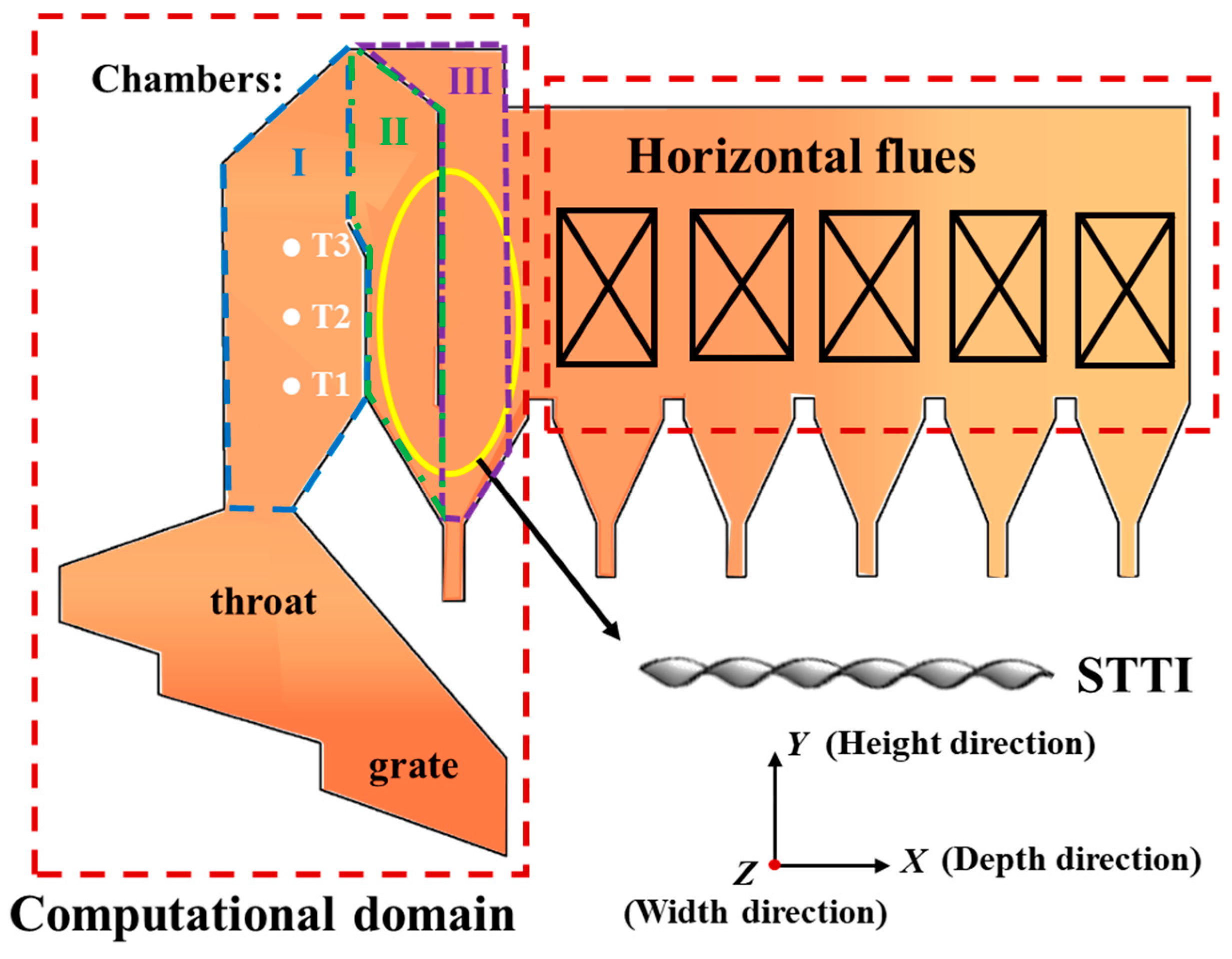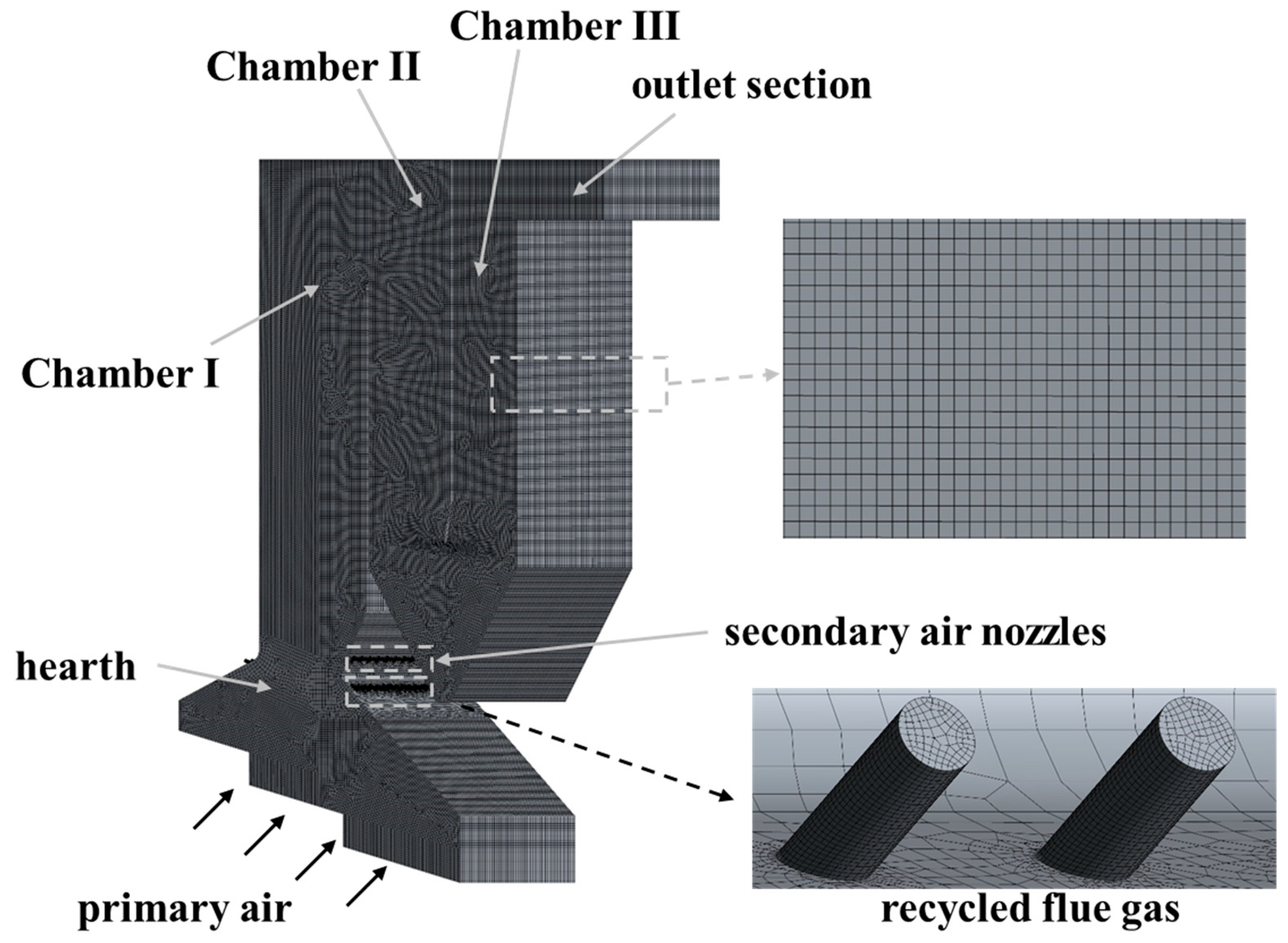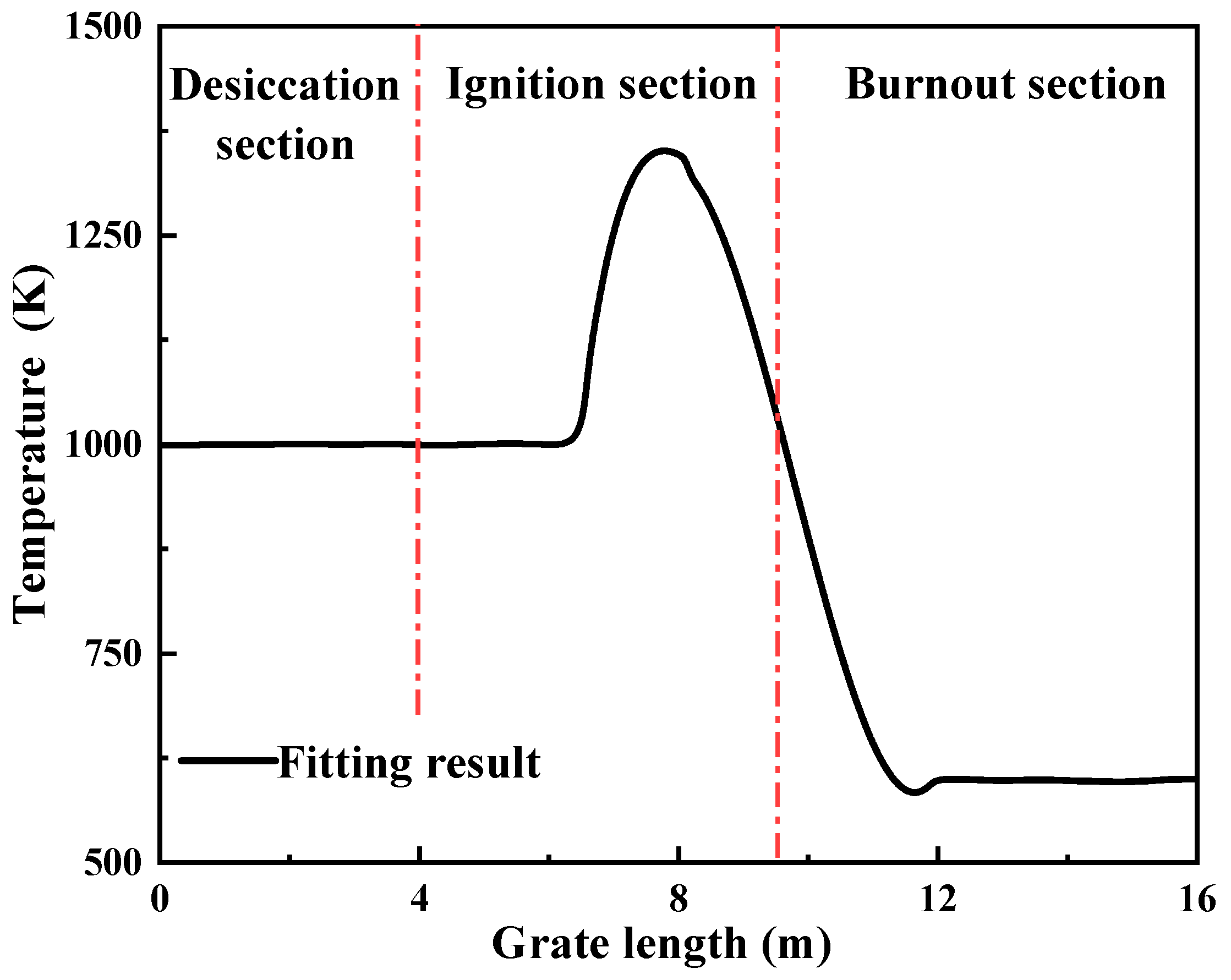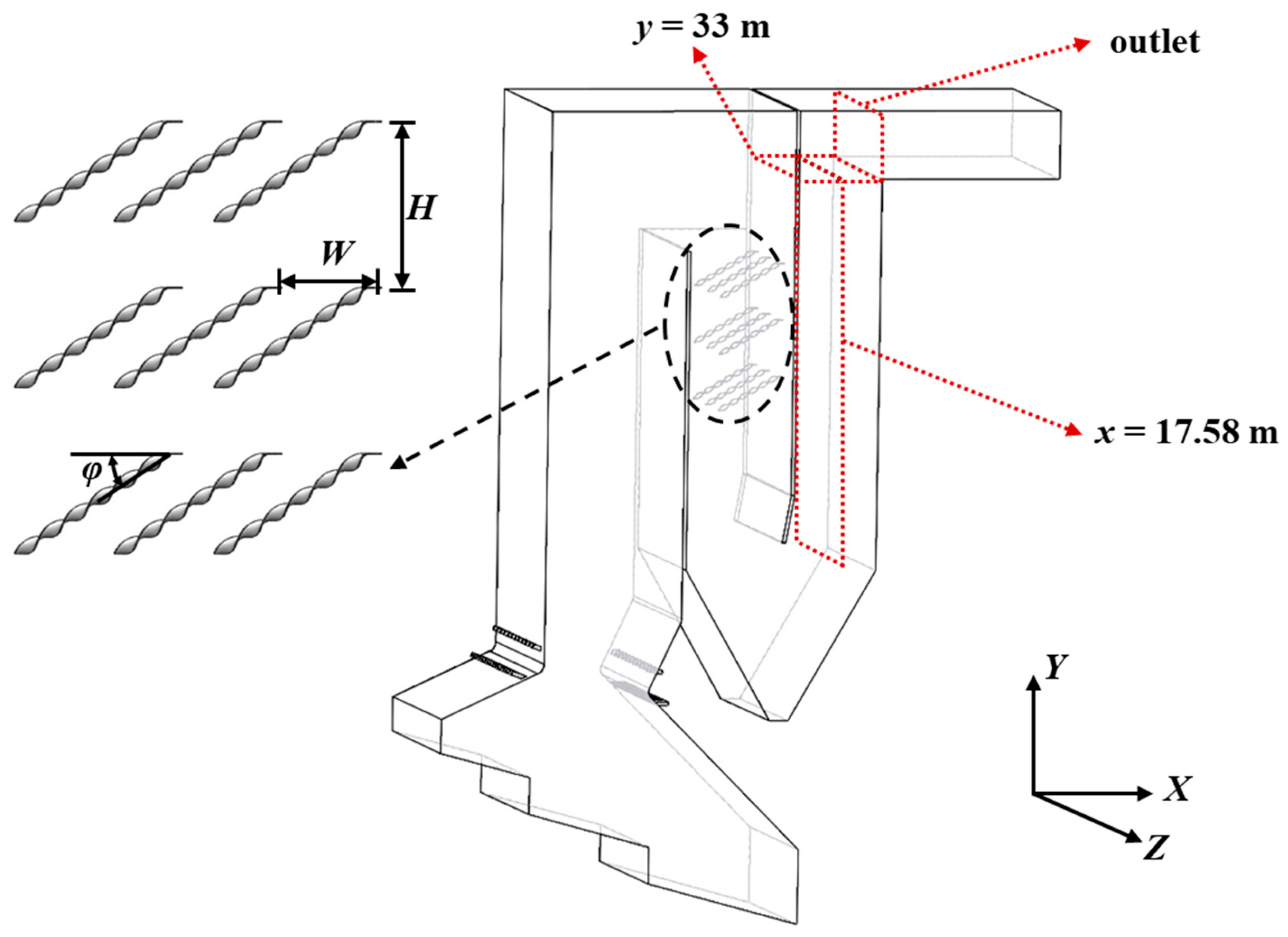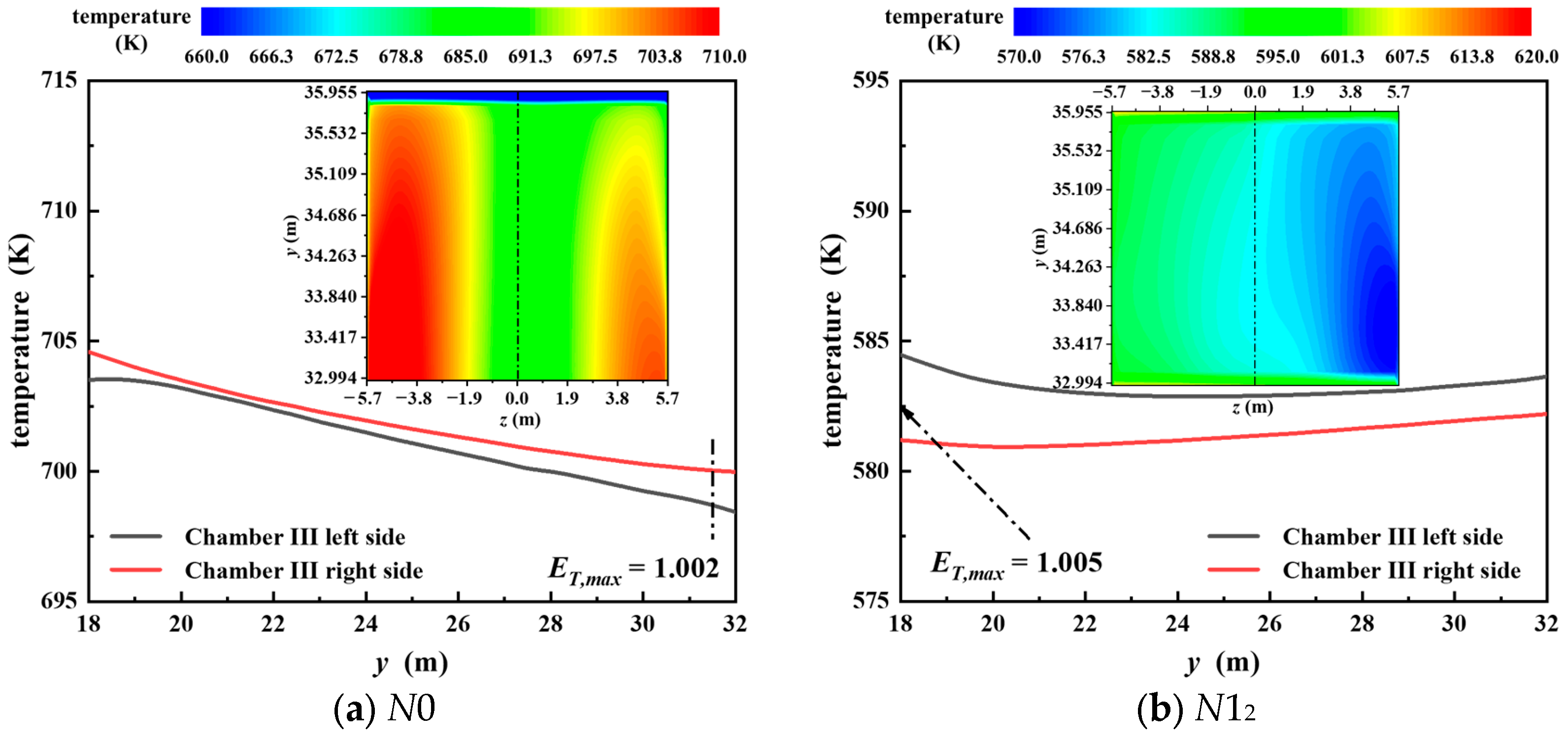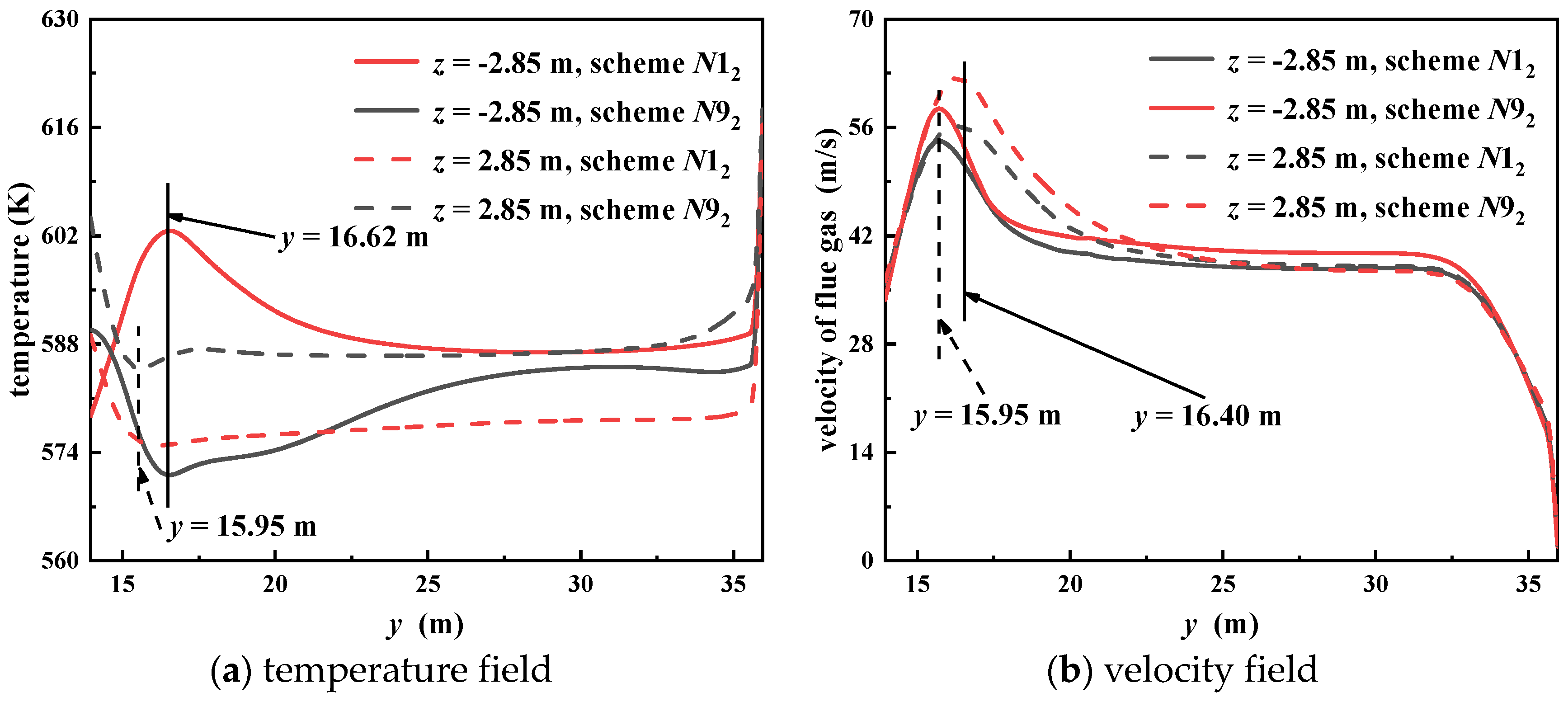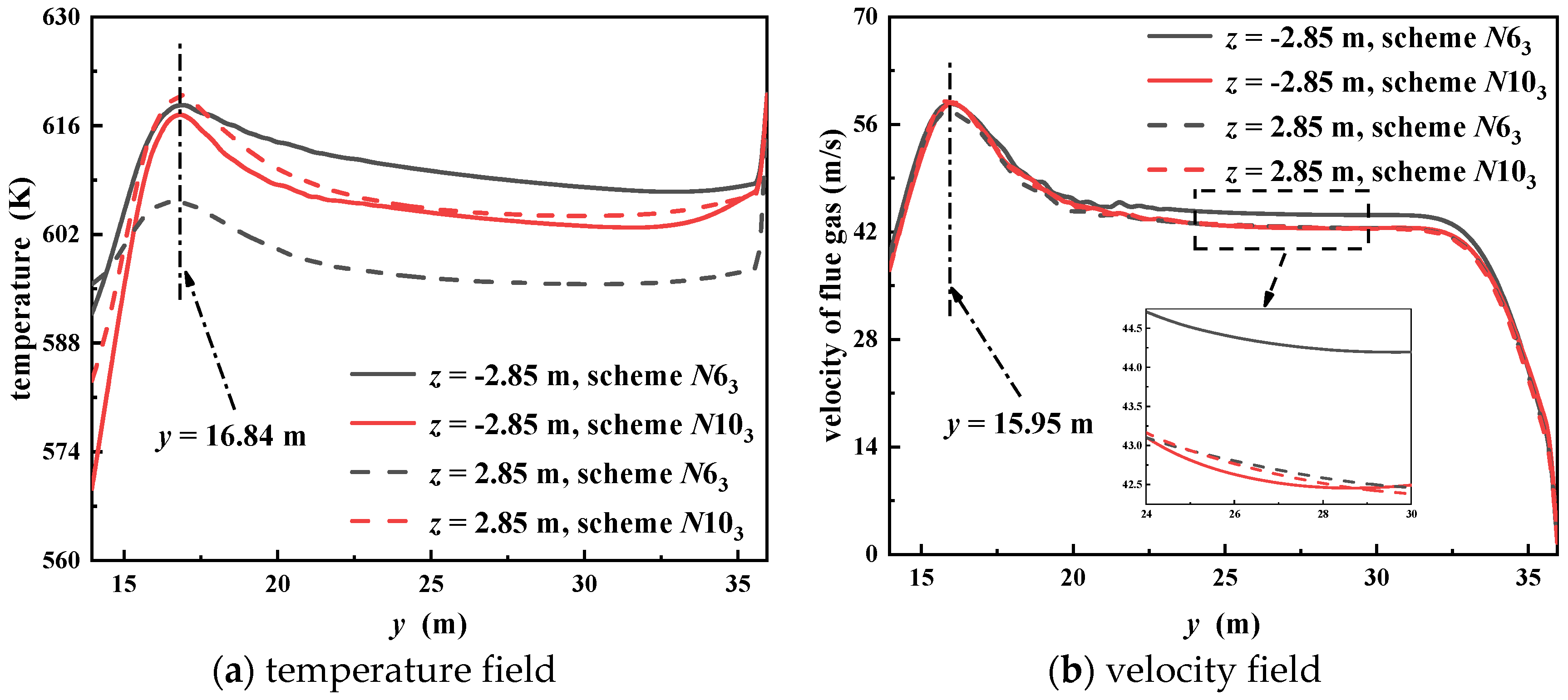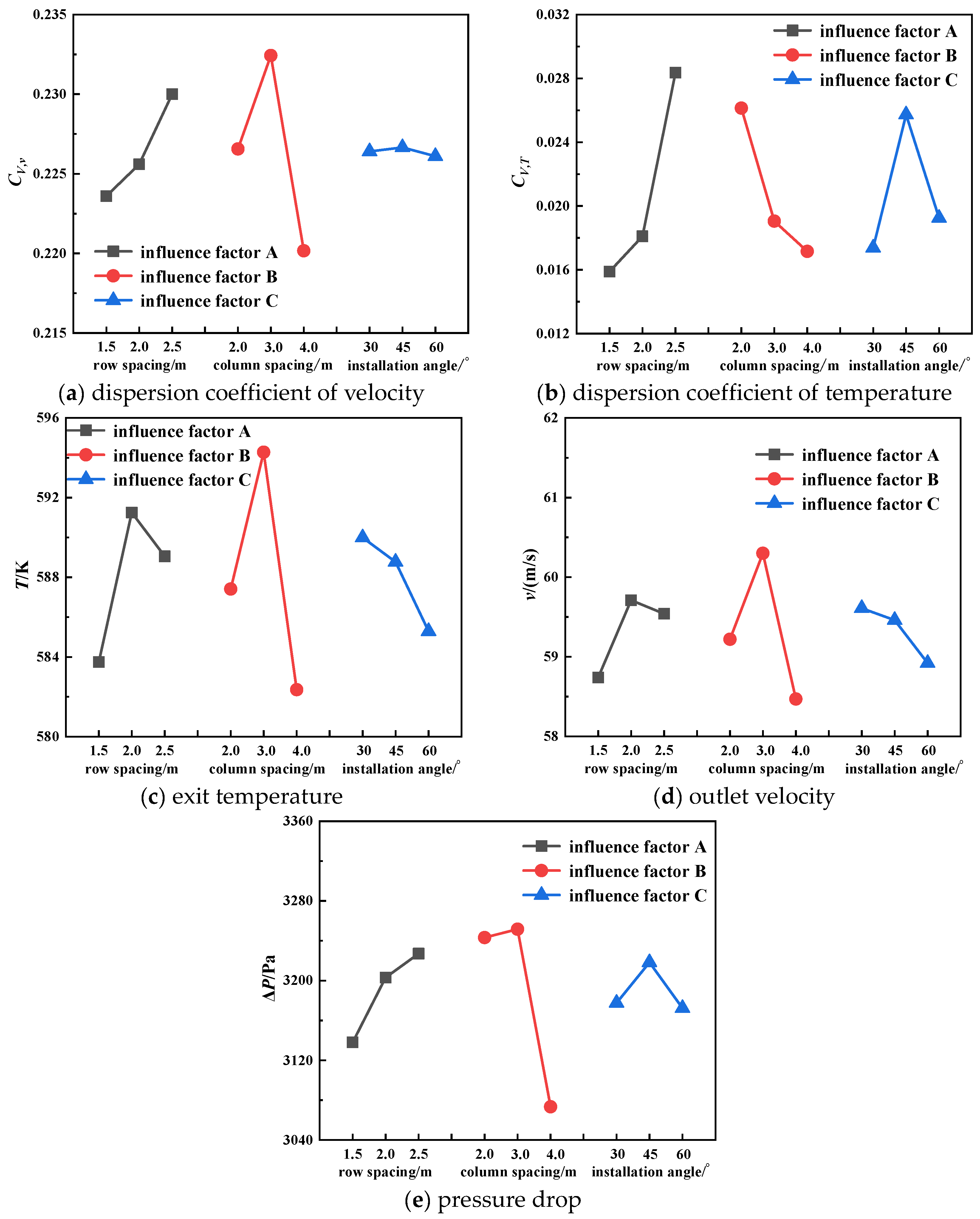Three schemes for the arrangement of STTIs are introduced in this work, including separate installation in chamber II, separate placement in chamber III, and simultaneous arrangement in both chamber II and chamber III. An orthogonal experimental method is adopted with the help of a numerical simulation method to achieve the optimal installation scheme.
3.2. Analysis of Separate Installation in Chamber II
Under the condition of separate installation in chamber II, nine specific configurations discussed in this section are denoted as ‘
N1
2~
N9
2′ in
Table 7, while
N0 represents the case without STTI. It is worth mentioning that the first row of tape inserts is mounted at a height of 29 m, with the second column at the center section in the width direction. Other tape inserts are arranged according to the row spacing, column spacing and installation angle introduced in
Table 7. Focused on the outlet section, simulation results can be obtained with dispersion coefficients for evaluation. Among nine specific configurations, when STTIs are placed with a row spacing of 1.5 m and a column spacing of 2 m at an installation angle of 30°, the velocity dispersion coefficient reaches the smallest value of 0.1866. In other words, the uniformity of the flow field shows visible improvement when choosing the arrangement scheme of
N1
2. From the perspective of the temperature dispersion coefficient, the result of scheme
N1
2 is 5.03% higher than that of scheme
N6
2. Although the temperature distribution is in direct connection with the velocity field, the complexity of thermal boundary conditions determines that taking mere velocity or temperature as an evaluation indicator is insufficient for the comprehensive performance of the grate furnace.
Adding simulation results corresponding to levels 1, 2, and 3 of each influence factor into the sum,
K1,
K2, and
K3 and correlative average values
k1,
k2, and
k3 can be obtained. Then, the range
R can be calculated to describe the impact of row spacing, column spacing and installation angle. Ordered by the value of the range as revealed in
Table 8, it can be observed that the column spacing plays a significant role in the uniformity of the flow field, followed by the installation angle and the row spacing in turn. In terms of the temperature dispersion coefficient, the degree of influence concerning three influence factors is in the sequence of
C >
B >
A. Through comparison of correlative average values, all of them reach the minimum value at level 1. Taking the homogeneity of the velocity field into account, the best combination method is
A1B1C1, written as experimental scheme number
N1
2. It is consistent with the condition concerning the temperature distribution. Therefore, the STTI should be arranged with a row spacing of 1.5 m and a column spacing of 2 m at an installation angle of 30°.
Selecting the optimal configuration method (
N1
2) and comparing it with the case without STTI (
N0),
Figure 8 illustrates the transformation of average velocity on the left side and the right side, which also reflects the flow condition of flue gas. The vertical coordinate represents the average value of velocity. Also worth noting is that the flow direction is identified as the positive direction of the horizontal coordinate. The grey line stands for the value of the left side (10.90 m <
x ≤ 13.24 m) and the red line for the right side (13.24 m <
x ≤ 15.58 m) of chamber II. From the top of the flue, which is regarded as the starting point of the horizontal coordinate, the velocity of flue gas on the right side increases rapidly in the 5 m long distance. Owing to the existence of the corner connecting chamber I and chamber II, the fluid velocity on the left side of the center section in depth reaches the peak and drops rapidly, which coincides with
Figure 5.
At diverse heights, both sides of the cross section correspond to different average values of physical quantities, which can be written as
xL and
xR. Defined as
, the deviation ratio
Ex is utilized to reflect the uniformity of the flow field. A larger value implies more serious unevenness. In the initial case without STTI, the maximum velocity deviation ratio
Ev reaches 13.03 because the flow rate of flue gas on the right side almost remains the same below a certain height. When STTI is arranged with a row spacing of 1.5 m and a column spacing of 2 m at an installation angle of 30° (scheme
N1
2), the maximum value of the velocity deviation ratio between the right side and the left side is 6.75. The 48.20% reduction indicates an improvement in the uniformity of the flow field. Additionally, it can be perceived that a temporary fluctuation occurs in curves of velocity as marked with a dashed box in
Figure 8a. The discontinuous increase in velocity can be attributed to the existence of the flow dead zone, behind which a decline in velocity occurs. Such variation flattens out with the application of STTIs.
Separate installation in chamber II not only exerts influence on the flow field of the current chamber but also makes a difference to that of the succeeding chamber. Taking the center section chamber II (
x = 17.58 m) in the depth direction as the separatrix,
Figure 9 demonstrates the transformation of average velocity along the flow direction, which does not take the flow direction into account. It can be seen that velocity appears in a downward trend in the flow process from chamber II to chamber III, with an average velocity of the right side (17.58 m <
x ≤ 19.43 m) above 60 m/s and that of the left side (15.73 m <
x ≤ 17.58 m) below 20 m/s. By comparison, the existence of STTI accelerates the flow disturbance and increases the average velocity. The positions where the maximum value of the velocity deviation ratio occurs are labeled with dotted lines. From the perspective of the velocity deviation ratio, the maximum value can reach 4.16 without the adoption of the STTI. After a separate arrangement in chamber II as scheme number
N1
2,
Ev,max declines to 3.67. The discrepancy between average velocities on two sides narrows, as seen in
Figure 9b. The velocity on the left side undergoes an acceleration of 27.83% compared with that in
Figure 9a.
Long-term operation at high temperatures increases failure probability and accumulates more fly ash particles. Apart from the velocity field, the temperature distribution also alters during the flow process in chamber III from the bottom to the top. The temperature contours of
Figure 10 intuitively reflect an alteration in the top section of chamber III. No tape being inserted in chamber III notwithstanding, separate installation in chamber II brings down the average temperature of chamber III to 584.19 K. Hence, reasonable use of STTI is beneficial to prolong the service life and promote heat transfer efficiency.
In addition to the depth direction, inhomogeneities of velocity and temperature also exist in the width direction. As displayed in
Figure 10, the position where the maximum value of the temperature deviation ratio occurs is also marked with dotted lines. The front half of the diving line (
z = 0 m) has a higher temperature than the back, which will give rise to uneven distribution of temperature in subsequent heating surfaces such as the superheater. The general reason for flue gas temperature deviation can be attributed to the local velocity misalignment. For a more intuitive comparison, the local temperature at representative positions is provided instead of the average temperature.
Figure 11 depicts the variation in velocity and temperature along the width direction in chamber III, where the solid line represents the value at
z = −2.85 m (the front side) and the dashed line at
z = 2.85 m (the back side). Simulation results of schemes
N1
2 and
N9
2 are plotted. The former presents a smaller deviation in both velocity and temperature than the latter, which accords with the conclusion that the best configuration corresponds to scheme
N1
2. Additionally, there is little difference between the locations of maximum velocity in the front and the back side, as well as that of the thermal peak. From
Figure 11, fluid on the front side reaches the maximum velocity at
y = 15.95 m, while the highest speed is detected at
y = 16.40 m on the back side. For the sake of inertial force and centrifugal force, the junction connecting chamber II and chamber III amplifies the uneven degree of flue gas, which originates from chamber II. Consequently, separate installation of STTIs can make an improvement to the flow field in chamber III.
3.3. Analysis on Separate Installation in Chamber III
Different from the scheme of separate installation in chamber II, in this section, the mounting height of the first row is
y = 21 m. Specific configurations are determined in relation to the row spacing, the column spacing, and the installation angle, assigned as ‘
N1
3~
N9
3’. Simulation results of dispersion coefficients about velocity
CV,v and temperature
CV,T in the outlet section are listed in
Table 9. Among these data, evaluating indicators about velocity achieves a minimum of 0.2196 with a row spacing of 2 m and a column spacing of 4 m at an installation angle of 30° (scheme
N6
3). Under this circumstance, the temperature dispersion coefficient also attains the minimum value of 8.752 × 10
−3.
As the above preliminary comparison with data value is insufficient, a range analysis is carried out to calculate the range
R = max(
K1,
K2,
K3) − min(
K1,
K2,
K3), as indicated in
Table 10. For the velocity field, ranges concerning three influence factors satisfy the relation of
RB >
RA >
RC. To put it another way, the column spacing plays the most significant role in the homogeneity of velocity in the outlet section while the installation angle is the least influential. When it comes to temperature, the ranking result of the effect exerted by influence factors is
A >
B >
C. The minimum value of
CV,v is achieved at level 1 of influence factor
A, with level 3 of influence factor
B and level 1 of influence factor
C. The same conclusion can be drawn in terms of the temperature dispersion coefficient. Hence, the best combination method is
A1B3C1, which is not comprised of nine configurations in
Table 9 and is expressed as
N10
3. The result under the circumstance of
H = 1.5 m,
W = 4 m and
φ = 30° should be compared with that of scheme
N6
3.
Great emphasis is placed on the flow conditions of the flue gas in chamber III, the variation in which along the width direction is illustrated in
Figure 12. After dividing the center section in depth into front and back sides by a line of
z = 0 m, comparisons can be made concerning velocity and temperature. The grey curve stands for the numerical results of scheme
N6
3, while the red one stands for scheme
N10
3. Since no STTI is arranged in the preceding chamber to alter the fluid distribution, the variation tendencies of velocity along the height direction are basically identical. The peak value emerges at
y = 15.95 m, after which the value decreases and stays almost invariant at a specific height. When flue gas flows close to chamber III, velocity will drop to zero due to the shift of flow direction. In the middle section with a constant value, the divergence of velocity between the front and back sides is 0.21 m/s for the case of scheme
N10
3 and only 14.23% of the value corresponding to scheme
N6
3. In general, the temperature distribution appears good following behaviors of the flow field. Analogous trends can be viewed in
Figure 12b. When STTIs are mounted with a row spacing of 1.5 m and a column spacing of 4 m at an installation angle of 30°, the temperature difference between the front and back sides is only one-tenth that of scheme
N6
3. From the perspective of the flow field in the width direction, the combination method
A1B3C1 has better effectiveness in improving the uniformity.
To undertake a comprehensive analysis of flow conditions in the width direction and the depth direction, various sections are extracted at different heights in both chamber II and chamber III. Substantial variation along the depth direction in chamber II is perceived in
Figure 13, with less than 20 m/s on the left side and over 60 m/s on the right. Separate installation of STTIs in chamber III will make a difference to the flow field of the junction connecting chamber II and chamber III. With the adoption of scheme
N10
3, the velocity distribution in this area is more uniform. Although the installation position is at the lower part, the uneven degree of velocity decreases through the upward flow process of flue gas in chamber III. Furthermore, the impact on the heating surface is lessened on both sides of the chamber. Therefore, the installation of STTI can optimize the subsequent flow field.
The flow situation of the outlet section determines the initial status of flue gas entering the horizontal flue. Consequently, it could be utilized to deduce the homogeneity of fluid in the grate furnace. The velocity field and the temperature distribution at the outlet section with the application of schemes
N6
3 and
N10
3 are displayed in
Figure 14. In the case of combination method
A1B3C1, flue gas at two sides of the center line at a width
z = 0 m tends to be distributed symmetrically in the contour of velocity. The presence of a thermal peak is more off-center in the width direction for scheme
N6
3, indicating a dramatic flue gas temperature deviation. Extracting values of velocity and temperature along the center line in height at the outlet section, a more uniform distribution of temperature can be observed near the top region of the chamber. Generally, scheme
N10
3 has a distinct advantage in homogenizing the flow field.
3.4. Analysis of Concurrent Arrangement in Chamber II and Chamber III
As mentioned above, the tape insert will make a difference to the succeeding flow field. In this section, an attempt is made to set up STTI in chamber II and chamber III concurrently. Given the results of scheme ‘
N1
23~
N9
23’, STTIs are mounted at the height of
y = 29 m,
y = 27.5 m and
y = 26 m in chamber II, respectively. The center lines of the three columns are located at
z = −2 m,
z = 0 m and
z = 2 m in the width direction, with an installation angle of 30°. On this premise, the first row of STTIs is arranged at the height of
y = 22 m in chamber III, slightly beyond the installation position in
Section 3.3. Other than dispersion coefficients, the exit temperature, the outlet velocity, and the pressure drop are also selected as evaluation indicators. Smaller values of these parameters are preferred for better performance.
A decrease in exhaust gas temperature is considered one of the main standards for appraising thermal efficiency, which is closely bound up with the exit temperature of chamber III. From the data listed in
Table 11, minimum values of all evaluation indexes can be obtained in the case of scheme
N3
23. When STTIs in chamber III are mounted with a row spacing of 1.5 m and a column spacing of 4 m at an installation angle of 60°, the exit temperature is 568.53 K—at least 15 K lower than that of other configurations.
The tendency chart of various factors at different levels is plotted in
Figure 15 on the basis of range analysis; thus, an intuitive comparison can be drawn between the effects of influence factors at three diverse levels. In the context of level 1 for influence factor
A, with level 3 for influence factors
B and
C, dispersion coefficients of velocity and temperature achieve the minimum value, together with the exit temperature, the outlet velocity, and the pressure drop. In other words, the optimal test scheme should be the combination method of
A1B3C3, which coincides with the conclusion of the preliminary analysis.
Seeing the disparity of significance between the five evaluating indicators, the matrix analytical method is applied to calculate weight matrixes for the determination of the optimum solution. Relevant procedures are as follows:
Build layer matrix
M based on average indicator values
kij of influence factor
i at level
j. Given that smaller values of indicators are in conformity with better optimal effect, reciprocals are taken as
kij = 1/
kij. After summarizing
kij at various levels, the layer matrix of factor
T can be obtained as
. Concerning range
Ri of influence
i, a layer matrix of level
S consisting of
can be constructed. Taking the dispersion coefficient of velocity as an instance, calculation results of layer matrixes are as follows:
With the definition of weight matrix as the multiplication, it can be expressed as
ω1 = M
1T
1S
1. Here, taking the dispersion coefficient of velocity as the indicator, after substituting values in step one, we can obtain
The global weight matrix is the average value of weight matrixes concerning five different evaluating indicators
. According to calculated data, the result is
According to an analysis of calculation results, the ranking result of impact made by influence factors is B > A > C. The maximum weight can be attained when level 1 is taken for influence factor A, with level 3 for influence factors B and C, corresponding to the combination method A1B3C3. Consistent with the preceding conclusion, STTIs in chamber III should be arranged with a row spacing of 1.5 m and a column spacing of 4 m at an installation angle of 60°, for the sake of optimal effects. To summarize, optimum test schemes for separate installation in chamber II and chamber III are N12 and N103, respectively, while that for concurrent arrangement in chamber II and chamber III is N323.
It is worth mentioning that the temperature difference between the left and right sides can exceed 10 K in the same chamber. Hence, great emphasis is laid on the flow field in the width direction.
Figure 16 illustrates the variation in velocity and temperature during the flowing process, where test schemes
N3
23 and
N10
3 are compared. With regard to the velocity of flue gas, a slower speed is achieved with the adoption of scheme
N3
23, which gives rise to a smaller velocity difference between the two sides. The same conclusion also applies to the temperature distribution. When arranging STTIs according to the scheme
N3
23, the average temperature difference in the width direction is 3.99 K—50.6% lower than that of
N10
3. Taking dispersion coefficients of velocity and temperature for assessment, a decreasing trend can be observed in the non-uniformity of the bottom-to-up flow in chamber III. Before flue gas is transferred from the vertical flue to the horizontal flue, values are in a steady uptrend in
Figure 16c, while the transformation in temperature is behind that of velocity. The corresponding values of scheme
N3
23 are smaller in contrast to scheme
N10
3, including the velocity dispersion coefficient
CV,v and the temperature dispersion coefficient
CV,T.
In order to discover the specific influence of installing STTIs in chamber III, an analysis of the flow field of the outlet section is also worth undertaking. The curves in
Figure 17 reflect values at the center line in the height direction, where red stands for scheme
N3
23 and grey indicates scheme
N1
2. With respect to the velocity of flue gas, the low-velocity region is concentrated in the range near
z = 0 m. From
Figure 17a, a depression in the middle with bulges on both sides is detected. Additionally, separate installation in chamber II is more effective in improving the inhomogeneity of gas distribution. The velocity distribution lays the foundation of the temperature field analysis. More attention is paid to variation in temperature distribution in the optimization process, which is directly correlated with the service life and operation efficiency of the grate furnace. With the implementation of STTI in chamber III under the optimal configuration, the exhaust gas temperature decreases by about 14.78 K.
A comparison is made between the flow field of three optimal test schemes under different conditions in contrast to that without the arrangement of STTIs. To exclude the influence of magnitude, uniformity indexes of the flow field concerning velocity and temperature are chosen to demonstrate the variation process of flow, as shown in
Figure 18. The larger uniformity index of temperature
γT indicates a more uniform distribution of temperature in the depth direction. As is vividly shown in
Figure 18a, the most distinct advancement takes place to the evenness of velocity when STTIs are installed separately in chamber II, with a row spacing of 1.5 m and a column spacing of 2 m at the installation angle of 30°. Scheme
N3
23 introduces tape inserts to chamber III. Under the optimal configuration, although no significant improvement is observed, the uniformity index of temperature increases to the range of 0.994~0.997. The existence of tape insert plays a proper role in optimizing the distribution of flue gas, especially in the depth direction.
The optimization of the flow field is related to operational safety and economic efficiency. Various sections at different heights in both chamber II and chamber III are extracted in
Figure 19 to display the transformation of temperature. The lower the temperature of the flue gas, the more the heat will be transferred to the heating surface. At the same time, more steam will be generated together with better waste heat utilization. In the initial flow field without tape insert (scheme
N0), it can be found that the temperature of most regions exceeds 650 K, which even reaches up to 700 K. A lower temperature can be achieved with the implementation of scheme
N1
2 compared with that under the condition of scheme
N10
3. On the premise of separation installation, STTI can be mounted in chamber II at the distance of 29 m, 27.5 m and 26 m from the bottom. For the sake of utility maximization, the spacing between the adjacent center of columns should be 2 m in the width direction, with an installation angle of 30°. As long as conditions allow, three columns of STTI can be arranged simultaneously in chamber III at the height of 22 m, 20.5 m and 19 m, located in sections of
z = −4 m,
z = 0 m and
z = 4 m at an included angle of 60° to the width direction. The minimum exhaust gas temperature of 568.53 K is achieved under this scheme—35.22 K lower than that under the circumstance of scheme
N10
3.
